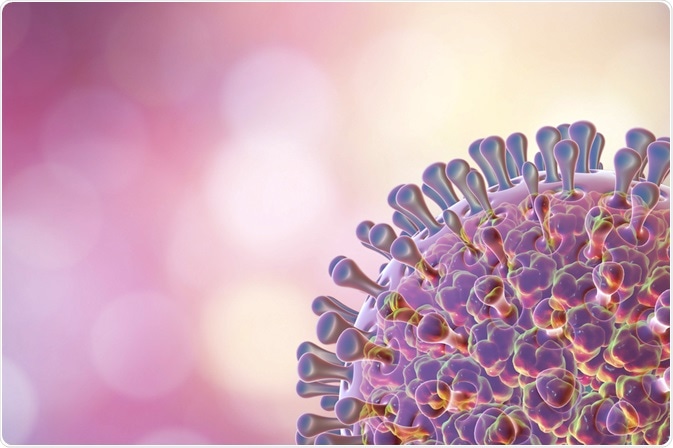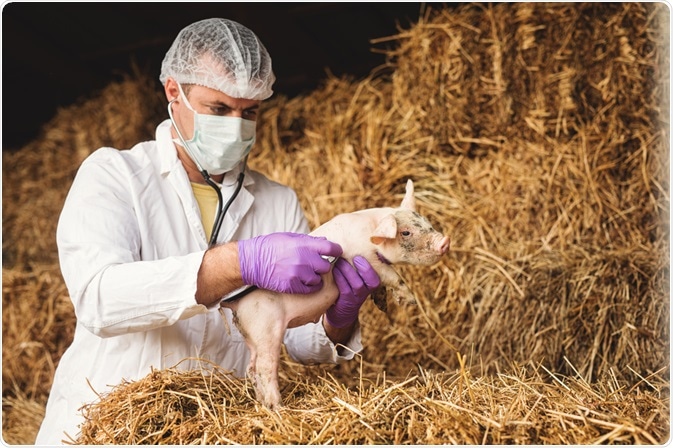Rotavirus, which is a genus within the family Reoviridae, is among the most important etiological agents of severe diarrheal illness in humans and animals around the world. The genome of this pathogen, consisting of 11 segments of double-stranded ribonucleic acid (RNA), is characterized by genetic variability including point mutations, genomic reassortment, and genome rearrangements that lead to its considerable diversity.

Image Credit: Kateryna Kon / Shutterstock.com
Animal rotaviruses are considered potential reservoirs for genetic exchange with human rotaviruses. There is now increasing evidence that animal rotaviruses can infect humans, either through direct transmission of the virus or by contributing one or several genes to reassortants with essentially a human strain genetic background.
Types of animal rotaviruses
Based on the antigenic sites located on the VP6 protein of the inner capsid, rotavirus strains are classified into five main (A, B, C, D, E) and two additional tentative (F, G) serotype groups, which are also known as serogroups. The rotavirus strains classified into serogroups A, B, and C are pathogenic for humans and various animal species.
The most virulent and commonly isolated strains belong to serogroup A and are known to cause acute infectious diarrhea in children, as well as various domestic mammalian and avian species. Serogroup B has been mainly associated with diarrhea in neonatal lambs, whereas Serogroup E strains have been isolated only from pigs. Serogroup D, F, and G strains have been isolated only from avian species.
In 1969, bovine rotavirus was the first group A rotavirus isolated in cell culture and confirmed as a cause of diarrhea in calves. The virulence of the strain and the age of the calf are important parameters in the pathogenesis of a rotaviral infection. Replacement of villous enterocytes is slow in newborn calves, which means that newborn calves are susceptible to disease caused by strains that are only moderately virulent.
Avian rotaviruses represent a diverse group of intestinal viruses, which may induce subclinical manifestations. However, these avian rotaviruses can also cause several diseases in poultry with symptoms of diarrhea, growth retardation, or runting and stunting syndromes. The latter can result in increases in feed conversion ratios and large economic losses to the poultry industry.
Rotaviruses can be found in virtually all pig populations; therefore, the detection of the virus in the feces does not entail a definite diagnosis. Neonatal and susceptible young growing pigs are exposed to viruses that are shed by carriers, including sows, or through exposure to the virus in their environment. The severity of the young pigs' clinical presentation depends on the dose ingested and the number of protective antibodies present in the dam’s colostrum and milk.
Group A rotaviruses have been isolated from dogs and cats, with a high seroprevalence in adult animals. Although the disease appears to be uncommon, mild enteritis is sometimes observed in young puppies less than 12 weeks of age. Canine rotaviruses appear to group together with the G3P[3] rotavirus strains.
Zoonotic potential
A large number of people are exposed to animal rotaviruses every year. Results of serological assays and nucleotide chain recognition methods have shown that many strains of rotaviruses isolated from mammalian species have the ability to infect humans. Furthermore, there has been strong evidence on the zoonotic transfer of avian strains.
Different examples of identical or (almost identical) transfer of animal rotaviral segments of the virus to humans are described in the literature. Most of these viruses refer to segments isolated from cattle or pigs, which have been detected primarily in developing countries with a close cohabitation of humans and animals. In the majority of cases, infection of humans by segments of animal origin leads to mild clinical disease.
Most domestic animal species can play a role in the spread of the virus by acting as natural reservoirs of the virus or as intermediate or end hosts. Due to the ability of the virus to overcome the barriers between species, it is also clear that animal strains may act as a natural source of viral genomes, thus promoting mutations and creating new viral genotypes with unknown virulence.

Image Credit: Dusan Petkovic / Shutterstock.com
Phylogenetic analyses of the rotavirus genome expose repeated intersections between the evolution of human and animal rotavirus strains, possibly as a consequence of multiple events of transmission between various animal species. The interspecies transmission and subsequent gene reassortment are significant mechanisms that drive the diversity of rotaviruses and enable the emergence of new pathogenic strains.
As mixed infections are a prerequisite for reassortment events, joint surveillance of animal and human rotavirus strains will be pivotal in gaining a better understanding of the relationships between co-circulating viruses, as well as assessing any relevant vaccination programs.
References
Further Reading
Last Updated: Nov 18, 2022